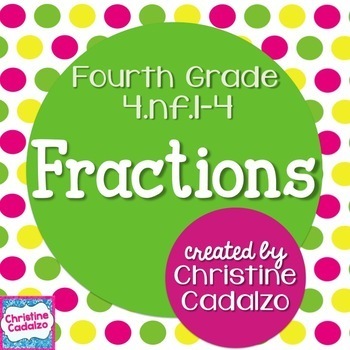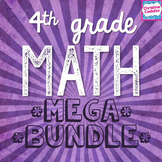Fourth Grade Fractions Bundle
- Zip
Products in this Bundle (3)
Also included in
- Includes ALL of my fourth grade Common Core math resources- math units, activities, games, assessments, and checklists. **Purchasing this product will also give you access to any future fourth grade math products that I create- they will be added to this bundle as they are created. As more fourth grPrice $184.31Original Price $231.38Save $47.07
- This is a complete fractions and decimals unit for teaching ALL of the Common Core 4.NF fractions and decimals concepts. It covers ALL of the 4.NF fractions and decimals standards from 4.NF.1-7, including: 4.NF.1-2: Comparing and Equivalent Fractions-comparing fractions with different denominators-Price $69.99Original Price $89.94Save $19.95
Description
Complete fractions unit for teaching the Common Core fourth grade fractions concepts. It covers the fractions standards from 4.NF.1-4, including:
4.NF.1-2: Comparing and Equivalent Fractions
-comparing fractions with different denominators
-comparing fractions with different numerators
-explaining comparisons by writing and drawing
-mixed comparison practice- different denominator or different numerator
-understanding the concept of referring to the same whole when comparing fractions
-using benchmarks (0, ½, 1, etc.) to sort and compare fractions
-using the “missing piece” strategy to compare fractions
-doubling to find equivalent fractions
-folding to find equivalent fractions
-tripling, etc. to find equivalent fractions
-why multiplying by the same numerator and denominator works for finding equivalent fractions
-determining if fractions are equivalent
-practice with making and finding equivalent fractions
4.NF.3: Adding and Subtracting Fractions
-building fractions from unit fractions
-word problems with building fractions
-writing equations to compose and decompose fractions
-adding and subtracting with like denominators
-solving word problems for adding and subtracting with like denominators
-writing word problems for adding and subtracting with like denominators
-finding multiple ways to compose and decompose a fraction
-writing and drawing to explain solutions and thinking
-understanding mixed numbers
-understanding improper fractions
-converting mixed numbers to improper fractions
-converting improper fractions to mixed numbers
-composing and decomposing mixed numbers
-composing and decomposing improper fractions
-writing equations for composing and decomposing
-understanding mixed number and improper fraction equivalence
-adding mixed numbers
-using the money model for understanding and adding mixed numbers
-solving and writing word problems involving mixed numbers
-subtracting mixed numbers
-using multiple strategies to subtract: build/ draw, count up on a number line, part/ whole relationships, converting to improper fractions, and traditional borrowing
4.NF.4: Multiplying Fractions and Word Problems
-understanding multiplying a fraction by a whole number as repeated fraction addition
-writing addition and multiplication equations
-solving word problems with multiplication of fractions and whole numbers
-writing word problems with multiplication of fractions and whole numbers
-explaining solutions in writing and drawing
-review/ reteach of multiplying fractions and whole numbers
-challenge/ enrichment of multiplying fractions and whole numbers
-using the Commutative Property to understand and multiply fractions and whole numbers
-using arrays to understand and multiply fractions and whole numbers
-finding multiply ways to compose a fraction with multiplication
Every lesson is differentiated with support and challenge ideas. You'll also find lots of higher order thinking questions to help students truly understand the concepts.
You'll get:
-detailed lesson plans
-a checklist of materials and prep for every lesson
-differentiation support and challenge ideas for every lesson
-colorful, engaging, and CLEAR slides to help students see the concepts
-engaging, hands-on activities to get kids interacting with the concepts
-games for practice and building fluency
-exit tickets
-an assessment checklist to help you track data
-vocabulary cards
-end of the unit assessment and answer key
-all the answers are included- either in the lesson plans or on a key
-printable student pages to keep kids engaged during the lesson and working on the material as they go
-Common Core standards
-engaging, higher order thinking questions in every lesson
Christine Cadalzo
Copyright 2012-2024
All Rights Reserved.




